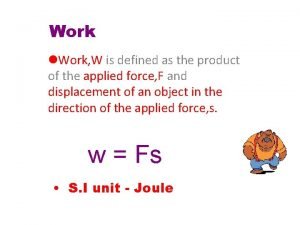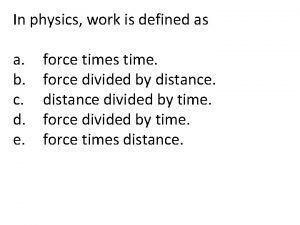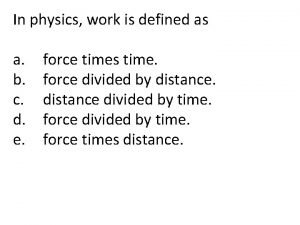Work Work is defined as the transfer of












- Slides: 12

Work

Work is defined as the transfer of energy from one body to another. Or more rigorously: W = ΔE (The Work-Energy Theorem)

We can calculate the work done on an object with: the units of work are Nm or Joules

Although a seemingly simple idea, the concept of work is often misunderstood. Let’s look at a few examples to help clarify. Example 1 - Work against Gravity How much work is required to lift a 2. 0 kg textbook from the floor to a height of 1. 5 m at a constant velocity? Note: W = Fd, but what force do we need to exert to lift the book at a constant velocity? Since the velocity is constant what is the net force acting on the book?

Example 2 - Work on an object How much work is done on a 4. 0 kg medicine ball that is held at a height of 1. 8 m for 10 s? Note: Is energy being used to hold the ball in this position? Well, yes…but… Is work actually being done ON THE BALL? No. The amount of energy the ball has remains unchanged.

Example 3 – Forces at an angle The youngster pictured to the right is pulling his sled at a constant velocity of 1. 2 m/s. He pulls the 15 kg sled with a force of 35 N at an angle of 40 o to the horizontal. How much work does he do in pulling the sled 20 m? Note: Draw an FBD showing the forces at work on the sled. Break Fboy into its vertical and horizontal components. Does the vertical component of the force do any work? Rule: When finding the work done on an object we only consider the component of the force that acts in the direction of displacement.

Example 4 – Fnet vs. Fa A biology student is pulling a crate 15 m along a level surface. The student pulls the crate with a force of 220 N while the force of friction is 120 N. How much work is the student doing? Note: To find the amount of work done by the student should we used Fnet or Fa? Rule: When finding the work done by a body we use Fa.

Hey wait a minute, if work is the transfer of energy what kind of energy is generated by the force of friction? Rule: When finding the amount of heat energy lost due to friction we use: EH (= Q) = Ff·d

Example 4 – continued Find the work done by friction and the net work done on the crate.

Example 5 – To scalar or not to scalar? Work is the dot (aka scalar) product of a vector and a vector. It is a scalar. However, work can be positive or negative… but how? Imagine that you bring a 1. 0 kg basketball from the floor to the top of a 1. 0 m table. How much work did you do?

Which direction did you exert that force? Now suppose the ball rolls off the table and falls straight down to the floor. How much work was done on the ball? Be careful: which direction is the force working on the ball now? Work can be negative when the force doing the work acts in the negative direction.

Another way of thinking of this is to remember that work is a transfer of energy. When you pick the ball up off the floor you are actually transferring energy to the ball in the form of potential energy. When the ball falls off the table, it is losing that energy.
 A collection of well-defined object
A collection of well-defined object What is a disturbance that transfers energy
What is a disturbance that transfers energy Work definition physics
Work definition physics Define of work done
Define of work done Work is defined as
Work is defined as In physics work is defined as
In physics work is defined as In physics, work is defined as
In physics, work is defined as Hình ảnh bộ gõ cơ thể búng tay
Hình ảnh bộ gõ cơ thể búng tay Ng-html
Ng-html Bổ thể
Bổ thể Tỉ lệ cơ thể trẻ em
Tỉ lệ cơ thể trẻ em Voi kéo gỗ như thế nào
Voi kéo gỗ như thế nào Tư thế worm breton là gì
Tư thế worm breton là gì























